Crafting a Welcome Email Flow That Converts
Learn how to create a 5-email welcome flow that converts subscribers into customers. Discover why welcome emails average 51% open rates and boost spending by 58%. Step-by-step guide included.
The welcome email is more than an introduction. It’s the first step toward building trust, loyalty, and sales. Imagine it as your brand’s handshake—a chance to greet your new subscribers, share your story, and make a lasting impression.
But it’s not just about saying “hello.”
It’s about turning curiosity into commitment.
Welcome emails are powerful. With open rates averaging 51% and subscribers spending 58% more after engaging with them, this flow is the cornerstone of successful email marketing.
In this first part of our series, we’ll dive into why your welcome flow matters and what makes it essential for your e-commerce business.

Why Your Welcome Email Flow Matters
Every new subscriber is an opportunity. They’ve shown interest. Maybe they found you through an ad, a referral, or a pop-up on your website. They’re curious. Your welcome email flow is your chance to turn that curiosity into action.
Here’s why it matters:
1. High Engagement
Welcome emails have the highest open rates of any email you’ll send—averaging 51%. Why? Because people are expecting them. They’ve just signed up, and they’re curious about what you have to say. It’s a rare moment where your audience is both engaged and eager. Don’t waste it.
2. Builds Trust
Your welcome flow is the first impression of your brand. It’s your chance to share who you are, what you stand for, and why you’re different. Customers are more likely to stick around if they feel connected to your story and values.
3. Drives Revenue
This isn’t just about warm fuzzies. Subscribers who engage with welcome emails are 58% more likely to make a purchase. And they don’t just buy—they spend more. A well-crafted welcome series can increase your average order value (AOV) and set the stage for repeat purchases.
4. Impacts Retention
When you welcome subscribers the right way, they stay. Research shows that a strong welcome flow leads to higher engagement over time. They open more of your emails, interact with your brand, and are less likely to hit “unsubscribe.”

Welcome Flow & Your Customer Journey
Think of your welcome flow as the bridge between interest and action. It’s not just one email—it’s a series that guides your subscribers. Each message builds on the last, moving them closer to their first purchase and beyond.
Here’s how it fits into the customer journey:
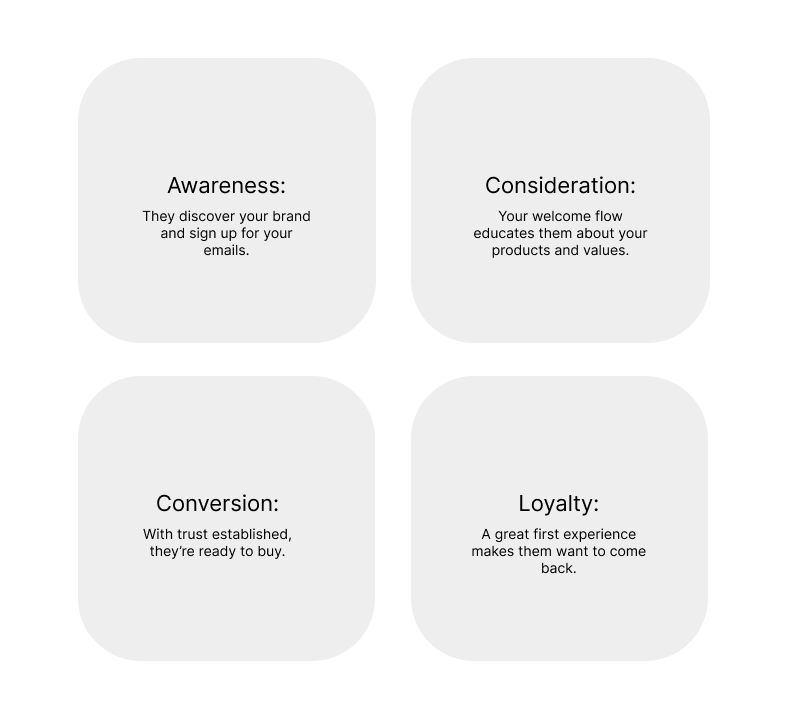
The journey starts here.
Get it right, and you’ll have customers who stay with you for the long haul.
Real-World Example:
Imagine you own an eco-friendly skincare brand. A new subscriber signs up for your newsletter after seeing an ad. They’ve shown interest, but they’re not sold yet. Your welcome email flow could look like this:
Day 0: A warm welcome with a short note about your mission to make sustainable skincare. Include a 10% discount to encourage their first purchase.
Day 1: A spotlight on your best-selling product—perhaps your organic face serum—with a testimonial to back it up.
Day 3: Share social proof, like reviews or before-and-after photos, to build credibility.
Day 7: Highlight what makes your brand unique, like ethically sourced ingredients or zero-waste packaging.
By the time they reach the end of the series, they know your story, trust your brand, and are ready to buy.
Why Most Welcome Flows Fail
Many brands treat welcome emails as a checkbox. They send a single, generic message and call it done. That’s a mistake because subscribers need more than a hello—they need reasons to care, trust, and act. A weak welcome flow leaves money on the table.
The key to success is consistency. A series of 3-5 emails, spaced over 7-10 days, gives you enough time to share your story, address objections, and guide your audience toward a purchase.
Crafting a Welcome Email Flow That Converts
The welcome email flow is your opportunity to build trust and guide subscribers toward becoming loyal customers. In Part 1, we explored why this flow is critical and how it fits into your customer journey.
Now, let’s take a deeper dive into the goals of a welcome email flow and the essential elements that make it high-performing.
Goals of a Welcome Email Flow
A welcome email isn’t just a pleasantry—it’s a powerful tool for achieving specific business goals. Every email in your flow should work toward these objectives:
1. Convert Curiosity into Commitment
Your subscribers are curious about your brand. They’ve already taken the first step by signing up, and now it’s your turn. Your welcome email flow should show them why you’re worth sticking with.
Share your story. What makes your brand unique? Highlight your values. Do you focus on sustainability, craftsmanship, or community? Address the “why” behind your products. How do they solve a problem or make life better?
2. Drive the First Purchase
Your welcome flow is the bridge between interest and action. It should create a clear path to their first purchase. Use incentives like a discount code or free shipping to sweeten the deal. Highlight your bestsellers or a curated collection tailored to new customers. Make the purchasing process simple with clear calls-to-action (CTAs).
3. Maximize the Value of Every Lead
Not every subscriber is ready to buy immediately. That’s okay. Use your welcome flow to educate them, showcase your products, and increase their average order value (AOV) when they do purchase. Introduce related products or bundles. Use product quizzes to help them find what fits their needs. Share customer testimonials that demonstrate value.
4. Build Trust and Loyalty
Trust isn’t built overnight. It takes consistent messaging, proof of your claims, and an emotional connection. Your welcome flow should plant the seeds of a long-term relationship. Include reviews, ratings, and social proof. Tell your subscribers how your brand delivers on its promises. Show them why your business stands apart from the competition.
Anatomy of a High-Performing Welcome Email
Every email in your welcome flow should work hard to inform, engage, and convert. Here’s how to build emails that deliver:
1. Start with a Strong Subject Line
Your subject line is your first impression. It’s what gets your email opened. Keep it simple, direct, and enticing. Examples: “Welcome to [Brand]! Here’s Your 15% Off Code 🎉” “Your Journey with [Brand] Begins Now.”
2. Deliver on Your Promise Above the Fold
Above the fold is the portion of your email that’s visible without scrolling. This is prime real estate for your most important message. Restate your welcome offer (if any). Include a bold CTA button like “Shop Now” or “Discover More.”
3. Use Clear and Compelling CTAs
Every email should have a singular goal. Use your CTA to guide readers toward that action. Examples include: “Claim Your Discount” “Shop Bestsellers” “Learn More About Us”
4. Highlight Products with Purpose
Your welcome flow is a great place to spotlight a few of your best products. Don’t overwhelm subscribers with too many choices—stick to one or two items per email. Feature products that solve common problems. Include benefits and social proof for added impact.
5. Build Credibility with Social Proof
People trust people. Use testimonials, reviews, and user-generated content (UGC) to show that others love your brand. Example: “Join over 10,000 happy customers who’ve made the switch to sustainable skincare.”
6. Design for Mobile
Over 60% of emails are opened on mobile devices. Make sure your welcome emails are optimized for smaller screens. Use short paragraphs and bullet points for easy reading. Ensure CTAs are large and tappable. Avoid heavy images that slow down loading times.
Real-World Application:
Let’s say you own a boutique coffee brand. Here’s how your welcome email flow might look:
Email 1:
Welcome Subject Line: “Welcome to [Brand]—Your Coffee Adventure Awaits!”
Body: Thank them for joining. Introduce your best-selling blend and include a 10% off code.
Email 2:
Product Spotlight Subject Line: “Meet Your Perfect Brew.”
Body: Highlight your subscription service and how it guarantees fresh coffee every week.
Email 3:
Social Proof Subject Line: “Why Coffee Lovers Choose Us.”
Body: Share testimonials and reviews. Include a CTA to browse your blends.
Email 4:
Brand Differentiator Subject Line: “Why Our Beans Are Better.”
Body: Explain your ethical sourcing and artisanal roasting process.
Ideas for Welcome Flow Emails
Welcome emails are the backbone of your email marketing strategy. They set the stage for your relationship with your audience, and the right flow can turn curiosity into loyalty.
Now that we have covered why welcome flows are important and anatomy of converting emails, we’ll break down the five essential emails that make up a high-performing welcome flow.
Each email serves a specific purpose in guiding your subscribers from interest to action. Let’s dive in.
The Five Essential Emails in a Welcome Flow
1. The Warm Welcome (Day 0)
The first email is your chance to make a strong first impression. It should be sent immediately after someone subscribes—when your brand is fresh in their mind, and they’re most engaged.
Start with gratitude and promise. Share your story, highlight your bestsellers, and remind them why they signed up. Showcase your best-sellers but don't overwhelm them. Make it easy to choose. If you promised them a reward for subscribing, like % discount, $ OFF, free shipping, etc. share that.
Purpose:
To introduce your brand, thank them for subscribing, and deliver any promised offers.
Content Ideas:
Thank You Note: Show appreciation for their interest.
Brand Introduction:
Share a short, compelling story about your mission or values.
Exclusive Offer:
If they signed up for a discount or freebie, deliver it now.
Clear CTA:
Guide them toward their next step, like browsing your products or learning more about your brand.
Example:
Subject Line: Welcome to [Brand]—Your Journey Starts Here! 🎉
Body:
Hi [Name],
We’re thrilled to welcome you to the [Brand] family!
Our mission is to [insert mission or values, e.g., make sustainable skincare accessible to everyone]. As a thank-you, here’s a 10% off code for your first purchase: [DISCOUNT CODE].
[CTA Button: “Start Shopping Now”]
2. Product Spotlight (Day 1)
Now that you’ve welcomed your subscriber, it’s time to highlight what you offer. The second email focuses on showcasing your bestsellers or curated collections.
This email's purpose is to help subscribers discover products that align with their needs and encourage exploration.
Content Ideas:
- Top-Selling Products:
Feature 3-5 bestsellers or customer favorites. - Benefits and Features:
Show how your products solve specific problems or meet common needs. - Interactive Tools:
Include a quiz or guide to help them find their perfect match.
Example:
Subject Line: Discover What Everyone’s Talking About!
Body:
Hi {{first_name}},
Meet our customer favorites: [Product A], [Product B], and [Product C]. Whether you’re looking for [specific benefit] or [specific feature], we’ve got you covered.
[CTA Button: “Shop Bestsellers”]
3. Social Proof Parade (Day 3)
Trust is the foundation of any customer relationship. This email builds credibility by showing that others already love your brand and to establish trust through testimonials, reviews, or user-generated content (UGC).
Let others do the talking. Testimonials, before-and-after shots, and glowing reviews show why your brand delivers.
Make sure they are authentic and relevant. Trust builds sales.
Content Ideas:
- Customer Testimonials - Highlight reviews that showcase your brand’s strengths.
- Before-and-After Photos - Show transformation stories or results.
- Community Highlights - Share UGC or statistics like “50,000+ happy customers.”
Example:
Subject Line: Why 50,000+ Customers Choose [Brand]
Body:
Don’t just take our word for it—here’s what our customers are saying:
“[Testimonial 1]”
“[Testimonial 2]”
“[Testimonial 3]”
Join the thousands who trust us for [specific benefit].
[CTA Button: “See More Reviews”]
4. The Differentiator (Day 7)
What sets your brand apart?
What makes you special?
Is it the ingredients? The craftsmanship? An ethical mission?
Compare yourself to competitors if it helps.
This email is your chance to highlight your unique selling proposition (USP) and tackle objections before they arise.
This email's purpose is to explain why your brand is the best choice and address common concerns.
Content Ideas:
- Unique Features:
Highlight what makes your product or service stand out. Behind-the-Scenes: Share your story, process, or ethical practices. - Competitor Comparison:
Show why your brand is the better option.
Example:
Subject Line: What Makes Us Different?
Body:
At [Brand], we believe in doing things differently.
Here’s how we stand out:
[Unique Feature 1]
[Unique Feature 2]
[Unique Feature 3]
Ready to experience the difference?
[CTA Button: “Shop Now”]
5. Brand 101 (Day 10)
The final email in your welcome flow deepens the connection. It’s less about selling and more about sharing who you are as a brand. The purpose of this email is to tell your story and share your value.
Content Ideas:
- Brand Story: Share the journey that led to your brand’s creation.
- Meet the Team: Introduce the people behind the scenes. Educational
- Resources: Link to blog posts, tutorials, or FAQs.
Example:
Subject Line: Let’s Get to Know Each Other Better
Body:
We’re more than a brand—we’re a community. Here’s a little more about us:
Our mission: [Insert mission]
Our values: [Insert values]
Our team: [Insert team highlight] Learn more about what drives us and how we’re making a difference.
[CTA Button: “Explore More”]
Example:
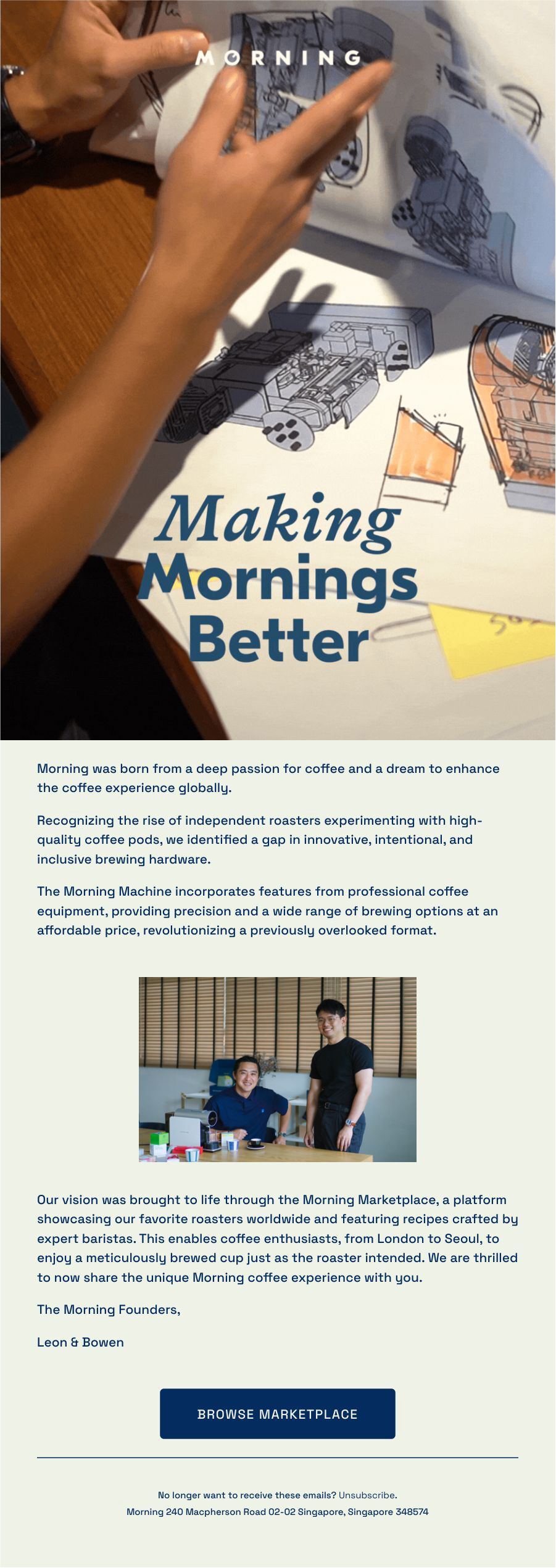
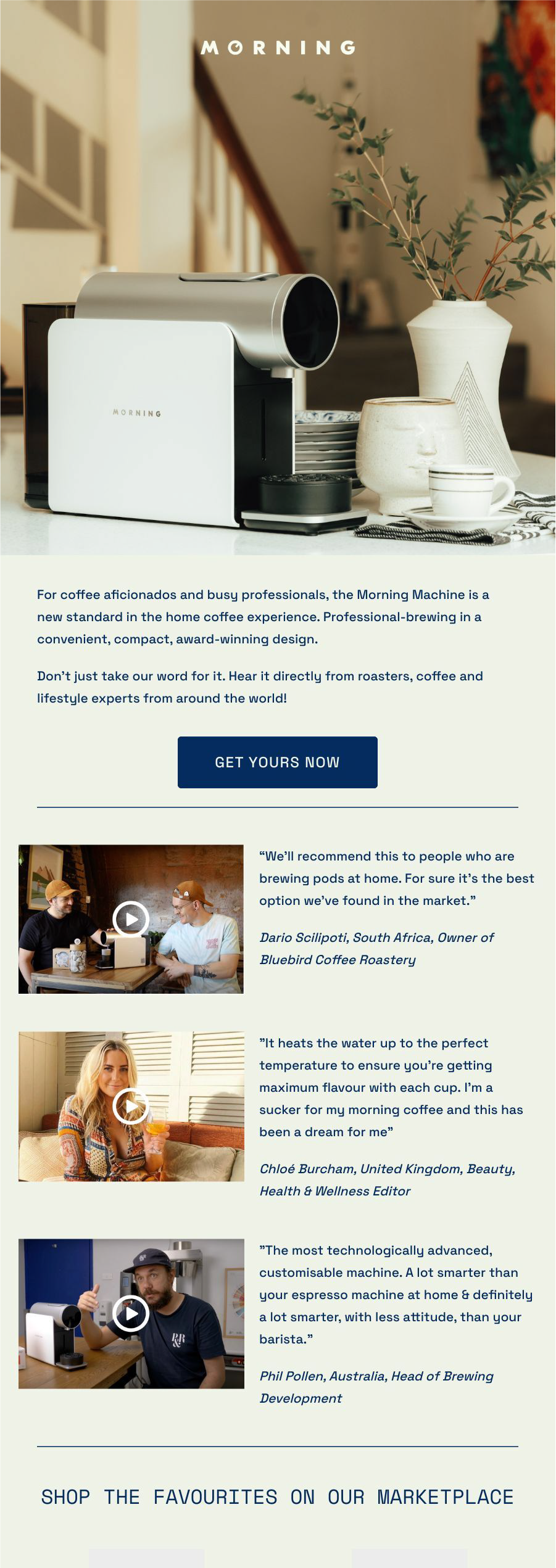
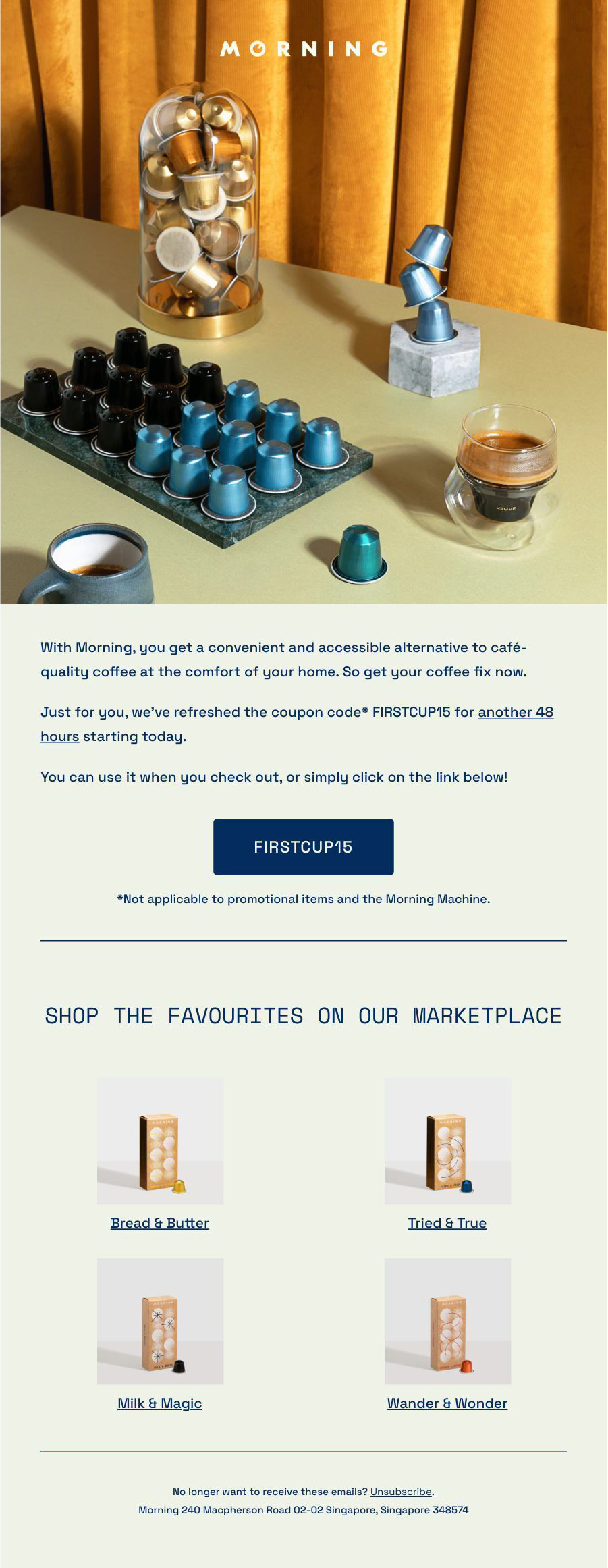
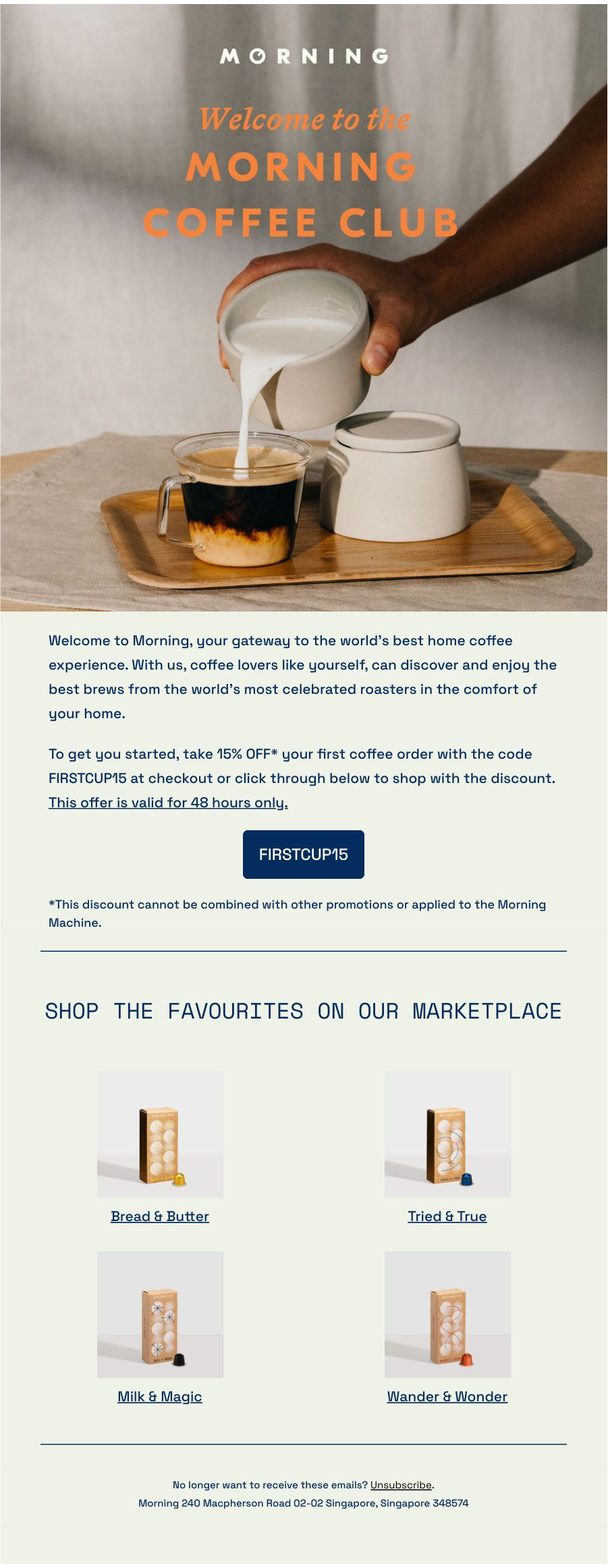
Why These Five Emails Work Together
Each email in this sequence serves a distinct purpose, but together, they create a seamless journey:
The Warm Welcome builds trust and excitement.
The Product Spotlight introduces subscribers to your offerings.
The Social Proof Parade establishes credibility.
The Differentiator addresses objections and sets you apart.
Brand 101 deepens the connection for long-term loyalty.
This flow isn’t just about selling—it’s about creating an experience that feels personal, valuable, and authentic.
Part 4 - Additional Tools & Strategies
A well-executed flow doesn’t stop at good content. To truly maximize conversions and loyalty, you need advanced strategies, tools, and optimization techniques.
In this final part of the series, we’ll cover personalization, A/B testing, and metrics to elevate your welcome flow to the next level.
Advanced Strategies for Optimizing Your Welcome Flow
1. Personalization: Make It About Them
Generic emails don’t work anymore. Subscribers expect personalized experiences tailored to their preferences and behaviors. Personalization can boost open rates, engagement, and conversions dramatically.
How to Personalize Your Emails:
- Use Subscriber Data: Include their name in subject lines or headers for a personal touch.
Example: “Welcome, Sarah! Your Next Adventure Starts Here.” - Behavioral Triggers:
Tailor emails based on browsing history, cart activity, or past purchases.
Example: If a subscriber visits a product page multiple times, feature that product in your next email. - Segment Your Audience: Separate subscribers by demographics, interests, or engagement levels to send more relevant content.
Example: “First-time buyers” vs. “Returning customers.”
Pro Tip: Pair email personalization with dynamic content. Tools like Klaviyo allow you to create one email template with blocks of content that change based on the recipient’s data.
2. A/B Testing:
Find What Works Even a small tweak can make a big difference. A/B testing helps you identify what resonates most with your audience by testing variations of your emails. This is only recommend for brands that are established and have enough data on their flows to clearly identify a winning element.
What to Test:
- Subject Lines:
Test direct vs. curiosity-driven subject lines.
Example:
“Your 15% Discount Is Waiting” vs. “Unlock Your Exclusive Welcome Gift.” - Call-to-Action (CTA):
Experiment with the wording and placement of CTAs.
Example: “Shop Now” vs. “Discover Our Bestsellers.” - Timing:
Adjust the intervals between emails in your flow.
Example: Test sending the second email after 24 hours vs. 48 hours. - Content Layout:
Try different email designs, such as text-heavy vs. image-driven emails.
Pro Tip: Focus on one variable at a time for accurate results.
Use Klaviyo’s built-in A/B testing features to streamline the process.
Tools and Platforms to Build a High-Performing Welcome Flow
The right tools make all the difference in executing an effective email flow.
Here are some of the best options for e-commerce brands:
1. Klaviyo - Built specifically for e-commerce:
Klaviyo is built specifically for ecommerce brands and offers powerful features that help it stand out as the lead ESP. With Klaviyo you have features like advanced segmentation, detailed data reports for decision making, automations and campaigns, and personalization features that are critical for email marketing success.
Offers seamless integration with Shopify, WooCommerce, and other platforms.
2. Mailchimp Great for beginners, Mailchimp provides:
Pre-designed templates for quick setup. Basic automation workflows. Integration with popular e-commerce tools.
3. ActiveCampaign - A robust option for advanced users:
Multi-channel workflows (email, SMS, and more). Predictive content and dynamic email blocks. Powerful reporting for data-driven decisions.
Pro Tip: Choose a tool that fits your business size and goals. Klaviyo is ideal for scaling e-commerce brands, while Mailchimp works well for smaller stores or startups.
Metrics That Matter: Measuring Success
A welcome flow is only as good as the results it delivers. Tracking the right metrics helps you identify strengths and areas for improvement.
Key Performance Indicators (KPIs):
Open Rate:
Measure the effectiveness of your subject lines.
Benchmark: 50%-60% for welcome emails.
Click-Through Rate (CTR):
Assess how engaging your email content and CTAs are.
Benchmark: 10%-20% for well-optimized flows.
Conversion Rate:
Track how many subscribers make a purchase after opening your emails. Benchmark: 2%-5%, but higher for targeted audiences.
Revenue Per Recipient (RPR): Calculate the direct revenue generated from each recipient in your flow.
Subscriber Retention: Monitor unsubscribes and engagement over time.
Pro Tip: Use analytics dashboards from your email tool to track these KPIs.
Review data regularly and iterate based on findings.
Welcome Flow Checklist Here’s your step-by-step guide to crafting a high-performing welcome flow:
✅ Map out your email sequence (e.g., 5 emails over 10 days)
✅ Write personalized subject lines for every email.
✅ Use segmentation to target specific lines for every email.
✅ Incorporate testimonials, UGC, and reviews for credibility.
✅ Highlight unique selling points (USPs) in your emails.
✅ Ensure all designs are mobile-responsive.
✅ Set up behavioral triggers for real time engagement.
✅ A/B test subject lines, CTAs, and timing for optimization.
✅ Track KPIs like open rates, CTR, and conversions to measure success.
With these strategies, tools, and metrics in place, your welcome flow can do more than convert—it can create loyal, lifelong customers. Now it’s time to implement, analyze, and refine your emails to achieve extraordinary results. Let’s get started!